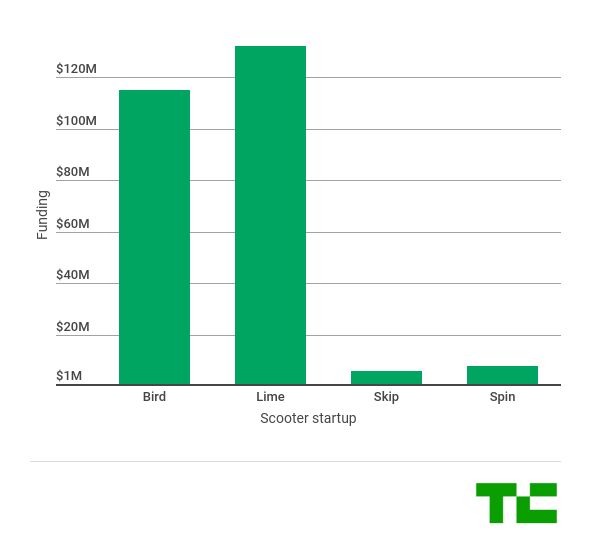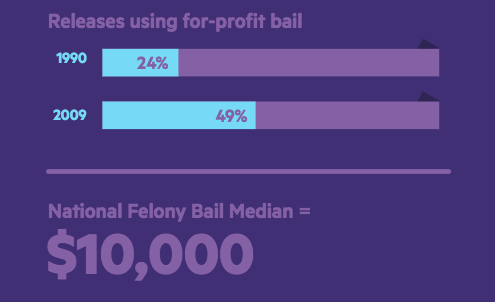On any given day in the United States, more than 450,000 people are behind bars awaiting their constitutionally mandated fair trial. None of them have been convicted of a crime — they’ve been accused of committing a crime, but no formal ruling of guilt or innocence has been made. That means these hundreds of thousands of people are incarcerated simply because they don’t have the financial means to post bail.
Bail was originally designed to incentivize people to show up for their court dates, but it has since evolved into a system that separates the financially well-off from the poor. It requires arrested individuals to pay money in order to get out of jail while they await trial. For those who can’t afford bail, they wind up having to sit in jail, which means they may be at risk of missing rent payments, losing their jobs and failing to meet other responsibilities.
Money bail is all too often a common condition to secure release from jail while a case is in progress. Cash bail systems result in leaving many people incarcerated, even though they haven’t been convicted of a crime.
The cash bail system in the United States is one of the greatest injustices in the criminal justice system, ACLU Deputy National Political Director Udi Ofer tells TechCrunch. Bail reform, Ofer says, is a “key way to achieve” the goals of challenging racial disparities in the criminal justice system and ending mass incarceration.
As we explored in “The other pipeline,” the criminal justice system in the United States is deeply rooted in racism and a history of oppression. Black and Latino people comprise about 1.5 million of the total 2.2 million people incarcerated in the U.S. adult correctional system, or 67 percent of the prison population, while making up just 37 percent of the total U.S. population, according to the Sentencing Project.
With a criminal justice system that disproportionately affects people of color, it’s no wonder why the cash bail system does the same. For one, people of color are 25 percent more likely than white people to be denied the option of bail, according to a pre-trial study by Dr. Traci Schlesinger. And for the black people who are given the option to pay bail, the amount is 35 percent higher on average than bail for white men, according to a 2010 study.
The national felony bail median is $10,000. For those who can’t afford it, they have to rely on bail bond agencies, which charge a non-refundable fee to pay the required bail amount on the person’s behalf. The bail bond companies, which are backed by insurance companies, collect between $1.4 billion and $2.4 billion a year, according to the ACLU and Color of Change.
And if bail bond companies are out of reach, those who are sitting in jail awaiting trial are more likely to be convicted of the crime they were charged with. The non-felony conviction rate rose from 50 percent to 92 percent for those jailed pre-trial, according to a study by the New York City Criminal Justice Agency. Along the way, leading up to the trial, some prosecutors incentivize people to plead guilty to the charges even if they’re innocent.
“It’s time to end our nation’s system of cash bail that lets the size of your wallet determine whether you are granted freedom or stay locked up in jail,” Ofer says. “Money should never decide a person’s freedom yet that’s exactly what happens every day in the United States.”
Pre-trial detention is also costly to local cities, counties and taxpayers. It costs about $38 million a day to keep these largely nonviolent people behind bars, according to the Pretrial Justice Institute. Annually, that comes out to about $14 billion to jail unconvicted people.
“The only people benefiting from bail is the for-profit bail industry,” Ofer said. “If we’re ever going to end mass incarceration in the United States, then we need to end cash bail.”
Bail reform is coming
Across the nation, bail reform has made its way into a handful of states. New Jersey’s bail reform law took effect last January; since then, its daily jail population has dropped 17.2 percent, and courts have imposed cash bail on just 33 defendants out of 33,400, according to the ACLU.
The ACLU itself is working on bail reform in 38 states, including California, where Ofer says he is optimistic reform will happen this year. Right now, a pre-trial release bill, Senate Bill 10, is up for consideration in the Assembly. The bill argues California should ensure people awaiting trial are not incarcerated simply because they can’t afford to pay bail. The bill also advocates for counties to establish pre-trial services agencies to better determine if people are fit to be released.
The bill, introduced by Senators Bob Hertzberg and others, is backed by the ACLU and Essie Justice Group, an Oakland-based organization that advocates for actual justice in the criminal justice system.
“Today we have a system that allows for people to be released pre-trial if they have enough money to afford their bail,” Essie Justice Group founder Gina Clayton tells TechCrunch. “Everyone else is required to sit inside of a cage without any way out.”
Essie Justice Group works mostly with and for women who have incarcerated loved ones. Often, the only way out for people is help from family or a plea deal, Clayton says.
“When we see people making the bail, we see that women are going into tremendous debt and are also beholden to an industry that has time and time again been cited and known to practice in quite an incredibly despicable way in terms of coercing and harassing their customers,” Clayton says. “When we think about who are the people who know about what’s going on with bail, it’s black and brown women in this country.”
For the past two years, Essie Justice Group held an action around Mother’s Day, with the goal of bailing moms out of jail or immigration detention. Last year’s action led to release of 30 women.

Photo via Essie Justice Group
Can tech help?
The short the answer is maybe. Earlier this month, Google banned ads for bail bonds services, which Clayton says is the largest step any corporation has taken on behalf of people who have loved ones in jail. But while tech can help in some ways, Clayton has some concerns with additional for-profit entities entering the criminal justice system.
“There are definitely tech solutions that I’m very against,” Clayton said, but declined to comment on which ones in particular. “I will say that my energy around this doesn’t come from an imagined place. I’m seeing it happen. One of the things we’re seeing is companies who are interested in bail reform because they see another opportunity to make money off of families. Like, ‘let this person out, but have them, at a cost, check in with people I hire to do this fancy but expensive drug testing three times a week, pay for an ankle shackle or bracelet and GPS monitoring.’ I think the companies that are making money off of those types of things are the ones we need to be wary of.”
There is, however, one for-profit company that immediately jumped to Clayton’s mind as being one doing actual good in the criminal justice space. That company is Uptrust, which provides text message reminders to people regarding court dates.
“I think that is a really great addition to the landscape,” Clayton says. “The reason I’m a proponent of theirs is because I understand their politics and I know what they won’t do, which is take it a step further or get involved with getting incentivized to add on bells and whistles that look less like freedom for people but more revenue for them.”
Uptrust, founded by Jacob Sills and Elijah Gwynm, aims to help people make their court dates. While the movies like to depict flight risks and people skipping town ahead of their court dates, failure to appear in court often comes down to a lack of transportation, work conflicts, not receiving a reminder, childcare or poor time management, Sills tells TechCrunch.
That’s where the idea came to humanize the system a bit more, by enabling public defenders to more easily connect with their clients. Uptrust is two-way in nature and reminds people on behalf of the public defender about court dates. Clients can also communicate any issues they may have about making it to court.
“If the public defender knows the client has an issue, they can usually get court moved,” Sills says. “But if they don’t have the information, they’re not going to lie on behalf of clients.”
Because public defenders don’t make much money, Uptrust doesn’t charge very much, Sills says.
“But they really care about the client and one of the things we saw with this was we needed to change the whole front end of the system to be less adversarial and more human,” Sills says.
In addition to text reminders, Uptrust enables public defenders to assist with other needs clients may have.
“A lot of stuff around bail reform is around risk assessment rather than need assessment,” Sills tells me. “But we saw a lot of these individuals have needs, like helps with rides, child care or reminders.”
Public defenders who are invested in the care of their clients can remind them via Uptrust to do things like ask for time off work or schedule child care.
For the end-user, the client, Uptrust is all text-based. For the public defenders, Uptrust offers a software solution that integrates into their case management systems.
Since launching in the summer of 2016 in California’s Contra Costa County, the court appearance rate improved from 80 percent to 95 percent, Sills says. To date, Uptrust has supported 20,000 people with a five percent FTA rate.
“As we improve product, if we can get [the FTA rate] down to 3 percent, you really can start taking that data and pushing forth major policy change,” Sills says.
Uptrust’s goal is to shift from risk assessment to needs assessment and ensure people are supported throughout their interactions with the criminal justice system.
“Our view is in terms of bail reform, we need to make sure there’s not a proliferation of things like ankle monitors and whatnot,” Sills says. “For us, success is really being a subcontractor to the community as well as working with the government. I think there’s a huge risk in bail reform as it relates to technology because people see it as a big business opportunity, If a company replaces the government, they may not have the community’s best interest in mind. So it’s important to keep in mind they have the community’s best interest in mind.”
Similar to Uptrust, a tech organization called Appolition works by operating within the confines of the system. Appolition, founded by Dr. Kortney Ryan Zieger, enables people to funnel their spare change into the National Bail Out fund. As of April, Appolition has facilitated over $130,000 to go toward bail relief. Ziegler was not available for comment for this story.
Promise, on the other hand, aims to provide an alternative to the cash bail system. In March, Promise raised a $3 million round led by First Round Capital with participation from from Jay-Z’s Roc Nation.
The idea is to offer counties and local governments an alternative approach to holding people behind bars simply because they can’t afford bail. With Promise, case managers can monitor compliance with court orders and better keep tabs on people via the app. GPS monitoring is also an option, albeit a controversial one.
Let’s say you get arrested and end up having a bail hearing. Instead of asking you to pay bail, the public defender could suggest a pre-trial release with Promise. From there, Promise would work with the public defender and your case manager to determine your care plan.
“It’s clear that our values are about keeping people out of jail,” Promise CEO Phaedra Ellis-Lamkins told me on an episode of CTRL+T. “Like, we’re running a company but we fundamentally believe that not just it’s more cost effective but that it’s the right thing to do.”
https://embed.simplecast.com/cd639b7b?color=3d3d3d
Instead of a county jail paying $190 per day per person, Ellis-Lamkins said, Promise charges some counties just $17 per person per day. In some cases, Promise charges even less per person.
It’s that for-profit model that worries Clayton.
“Whenever you bring in the for-profit ethos in a criminal justice space, I think we need to be careful,” Clayton says.
She didn’t explicitly call out any companies. In fact, she said she doesn’t feel ready to make a judgment on Promise just yet. But she has a general concern of tech solutions that “dazzle and distract system actors who we really need to hold accountable and see operate in more systemic, holistic ways.”
Solutions, Clayton says, look like social safety nets like hospitals and clinics instead of jails.
“If we want to really move ourselves away from this path we’ve been on,” Clayton says, “which is towards normalizing state control of people then we should be really careful that our system that once looked like slavery to Jim Crow to mass incarceration doesn’t then become tech surveillance of all people.”
from iFeeltech IT News Mix4 https://techcrunch.com/2018/05/20/bail-reform-has-a-complex-relationship-with-tech/
from
https://ifeeltechinc.wordpress.com/2018/05/20/bail-reform-has-a-complex-relationship-with-tech/
 More important are the software changes. There’s a new mobile app for iOS and Android that should make loading and sharing documents easier. A new screen sharing mode sounds handy but a little cumbrous — you have to plug it into a PC and then plug the PC into a display. And PDF handling has been improved so that you can jump to pages, zoom and pan, and scan through thumbnails more easily. Limited interaction (think checkboxes) is also possible.
More important are the software changes. There’s a new mobile app for iOS and Android that should make loading and sharing documents easier. A new screen sharing mode sounds handy but a little cumbrous — you have to plug it into a PC and then plug the PC into a display. And PDF handling has been improved so that you can jump to pages, zoom and pan, and scan through thumbnails more easily. Limited interaction (think checkboxes) is also possible.



